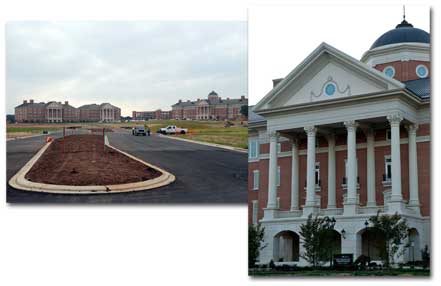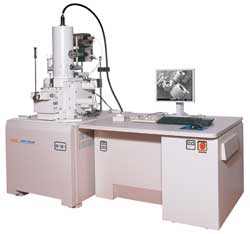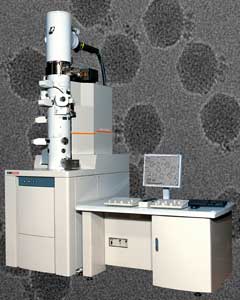Peabody, Mass., October 15, 2008 – Two of JEOL’s top-of-the-line cryo-electron microscopes will be key instrumentation for multi-disciplinary scientific advances in a new $1 billion research center in Kannapolis, North Carolina. The David H. Murdock Research Institute (DHMRI) has selected JEOL’s high resolution electron microscopes for its world-class laboratory, which will serve as a central resource to multiple university research institutes and private companies.

The vision and impetus behind this collaborative research institute is that of David H. Murdock, Chairman and sole owner of Dole Food Company, Inc., a Fortune 500 company, and Castle & Cooke, Inc. DHMRI was established through a private grant to escalate groundbreaking health and nutritional research and to initiate new discoveries in a number of areas, including biotechnology, obesity, cancer, agriculture and medical devices.
 “Mr. Murdock has done a remarkable thing. He has assembled together the world’s most advanced and diverse instrumentation under one roof so that investigators at the NCRC will have access to the latest cutting-edge technologies,” explained Dr. Randy Allen, Director of Business Development for DHMRI. Duke University, North Carolina State University, University of North Carolina (UNC) Greensboro, UNC Chapel Hill, UNC Charlotte, Appalachian State University, NC Central University, and NC A&T State University are among the institutions locating on the new research campus.
“Mr. Murdock has done a remarkable thing. He has assembled together the world’s most advanced and diverse instrumentation under one roof so that investigators at the NCRC will have access to the latest cutting-edge technologies,” explained Dr. Randy Allen, Director of Business Development for DHMRI. Duke University, North Carolina State University, University of North Carolina (UNC) Greensboro, UNC Chapel Hill, UNC Charlotte, Appalachian State University, NC Central University, and NC A&T State University are among the institutions locating on the new research campus.
JEOL USA President and CEO Robert Santorelli reports, “The philanthropic endeavors of this self-made individual are examples of what makes America great. I was particularly pleased to join our senior management team in the finalization of the contract with David Murdock. Although there are competitive products out there Mr. Murdock demonstrated his shrewd decision-making ability by selecting the best and most practical electron microscopes from the world’s most stable provider.”
DHMRI Board member Dr. Steven Lommel, Assistant Vice Chancellor for Research and Graduate Studies at North Carolina State University, added, “Mr. Murdock, through his philianthropic funding of the DHMRI, has allowed for the assembly and integration of the most comprehensive suite of scientific instruments and equipment that I am aware of. The JEOL electron microscopes, in synergy with the other spectroscopy and imaging facilities, will allow scientists to observe biological properties at the molecular and atomic level for the first time.”
Instrumentation destined for variety of research studies
To select the critical instrumentation for a wide range of research studies, Murdock selected Dr. John Mackenzie, Professor of Microbiology and Coordinator, Center for Electron Microscopy at North Carolina State University to serve as Interim Director of the Electron Microscopy Core Lab. “We are equipping t he Core Lab at the highest level of state-of-the-art instrumentation for standard and cryogenic samples,” Mackenzie said.
he Core Lab at the highest level of state-of-the-art instrumentation for standard and cryogenic samples,” Mackenzie said.
“In addition, the Core Lab will have state of the art sample preparation capabilities”
The JEOL Transmission Electron Microscope (TEM), the model JSM-2200FS, was selected for its ability to perform cryotomography, or 3D reconstruction, of plant viruses and plant proteins, and its inline energy filter and high resolution 4k x 4k camera. “It fulfilled a huge need in terms of high resolution imaging that you can’t get with some of the other scopes,” said Mackenzie. “The ability to operate with the high resolution camera systems over large sample areas is critical when examining the ultra-structural
pathology of plant and animal disease.”
The JEOL Scanning Electron Microscope (SEM), the new JSM-7600F, is a state of the art ultra high resolution thermal field emission SEM. The semi-in-lens objective lens, in lens detectors, in column energy filter, low angle BSE detector and beam deceleration technology together provide an FE SEM with ultra high resolution (down to the one nanometer scale) even at low accelerating voltage on uncoated, charge sensitive, and beam sensitive samples. “This SEM also provides an extremely stable beam over very long periods of time greatly simplifying high resolution FE SEM imaging, compared to the high resolution cold cathode FE SEMs of the past,” said Mackenzie. “The combination of the thermal in lens gun and the many column features provides a SEM that is both an ultra high resolution tool and a very flexible easy-to-use work horse SEM. This microscope can image the many diverse biological samples at the DHMRI in both standard and cryogenic modes.”
A new golden age of breakthrough research anticipated
Providing access to the most advanced scientific instrumentation, the DHMRI will attract distinguished researchers from not only the United States but from around the globe. An open house is scheduled for October 20th at the new research institute.
“JEOL is honored to have been chosen as a partner in DHMRI’s mission to truly enhance scientific knowledge. We join this world class center for research in anticipating great discoveries using JEOL’s advanced technology and applications expertise,” said JEOL USA’s Vice President and General Manager of Sales and Marketing, Peter Genovese.

https://www.jeolusa.com/NEWS-EVENTS/Press-Releases/PostId/69/New-David-H-Murdock-Research-Institute-Specifies-JEOL-Cryo-electron-Microscopes





